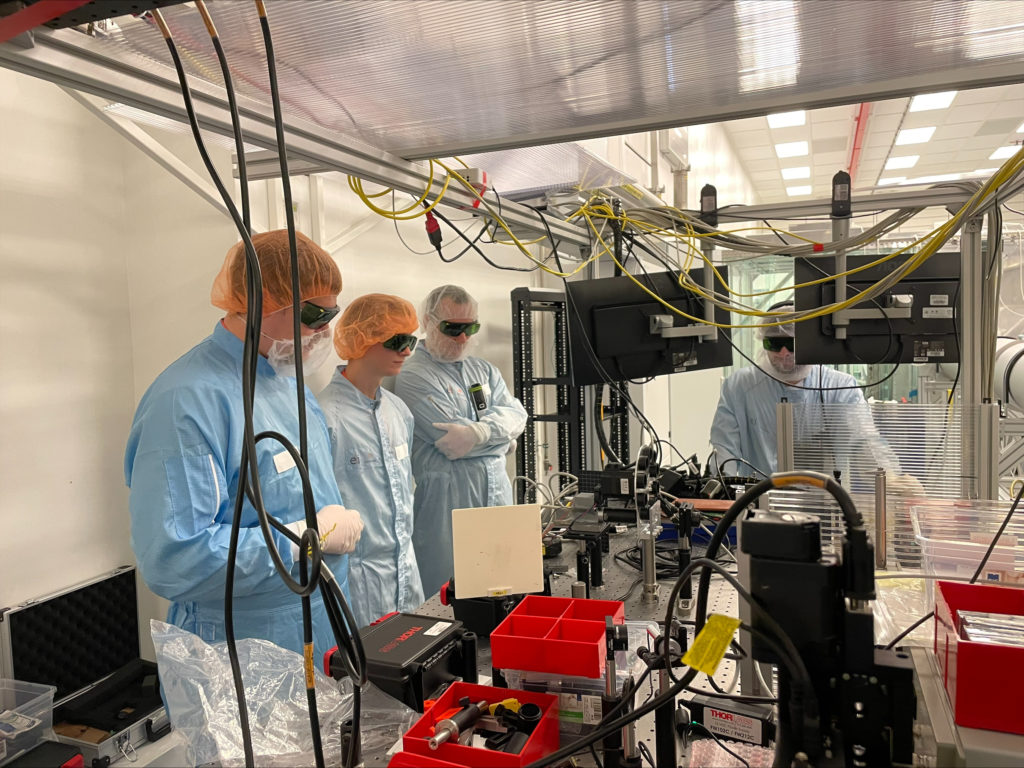
IMPULSE brings together LMU and ELI to develop characterisation techniques
At the end of May 2023, colleagues from the Ludwig-Maximilians-Universität in Munich (LMU) visited the ELI Beamlines Facility in Dolní Břežany to carry out measurements of the spatial-temporal coupling effect using the L3-HALPS laser beam in the E5 experimental hall. The scientific collaboration kicked off thanks to IMPULSE Task 3.2 which focuses on laser metrology.
The PW-class, high repetition rate L3-HAPLS laser at ELI Beamlines is focused down onto solid and gas targets to reach ultrahigh laser intensities and generate particle beams with unique features such as ultrashort bunch duration, high current per pulse, and high cut-off energy, which are of interest for applications in various fields.
“Characterisation of spatial and temporal properties of ultrashort lasers is in general done separately,” explains Davorin Peceli, Senior Laser System Researcher at ELI Beamlines. „However, when there is a significant correlation between these properties, the optimisation of high-power ultrafast lasers requires complete characterisation in space-time domain. At one of our IMPULSE meetings, it was brought to my attention that LMU colleagues developed a new technique, called fast acquisition of laser couplings using narrowband filters (FALCON)[1], that allows for this type of characterisation.”

This technique implements a new algorithm based on the expression of the spatio-spectral phase in terms of Zernike-Taylor coefficients together with a new experimental setup consisting of narrow band-pass filters in front of Shack-Hartmann wavefront sensor. The ELI Beamlines team first visited LMU in Munich to gather more information from the source and invited colleagues Nils Weisse and Jannik Esslinger to perform their measurement with the L3 laser, for which the local team had to adjust the setup of the E5 experimental hall.
„Collaboration between multiple facilities greatly enhances innovation in the challenging task of fully characterizing ultrashort laser systems,” says Nils Weisse and Jannik Esslinger from LMU. „We are delighted to have had the opportunity to exchange experiences and retrieve interesting results using our setup at ELI-Beamlines.”
There is a mutual interest to continue this successful collaboration from both sides. The team plans to repeat the measurement and at the same time compare results with INSIGHT, another commercial instrument that is capable of also measuring spatial temporal coupling in ultrashort lasers. Also, after carrying out the required additional changes in the E5 setup, they aim to perform the measurement in full configuration with alpha and beta amplifiers.
„I’ve been working with high-power laser diagnostics at ELI Beamlines for 10 years now, and this project is an exciting opportunity for me as well, showing that we can always find new areas to discover in physics,” adds Davorin Peceli. „Spatial-temporal coupling is a very important diagnostic measurement method that is required for the optimisation of laser performance. Even though we still want to compare it with other methods, FALCON seems like a good approach to this.”
[1] N. Weisse, J. Esslinger, S. Howard, F. M. Foerster, F. Haberstroh, L. Doyle, P. Norreys, J. Schreiber, S. Karsch, and A. Döpp, “Measuring spatio-temporal couplings using modal spatio-spectral wavefront retrieval,” Opt. Express 31, 19733-19745 (2023)